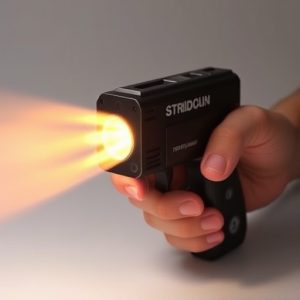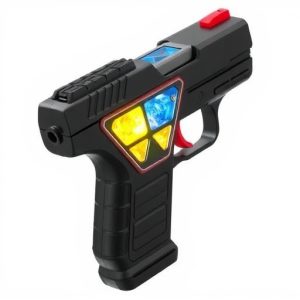Taser vs Stun Gun: Unlocking Differences in Non-Lethal Weapons
Tasers (Conducted Electrical Weapons or CEWs) are less-lethal tools preferred by law enforcement for…….
Tasers (Conducted Electrical Weapons or CEWs) are less-lethal tools preferred by law enforcement for crowd control and self-defense due to their unique firing mechanism. They use spring-loaded cartridges to launch two fine probes, delivering an electric shock that temporarily paralyzes muscles without causing permanent harm. Advanced models feature safety features like automated targeting and de-escalation modes, making them superior to traditional stun guns or triad stun guns in unpredictable situations. Tasers were developed in the 1960s and gained commercial availability in 1985, combining Electric Muscle Disruption (EMD) technology with bright lights and loud sounds for enhanced disorientation in security and law enforcement scenarios.
“Unraveling the differences between Tasers and Stun Guns: A Comprehensive Guide. This article delves into the distinct worlds of these non-lethal weapons, offering a detailed exploration from technology to legality.
We start with ‘Understanding Tasers’—a look at their history, function, and legal status. Then, ‘Exploring Stun Guns’ dissects their unique features, operating mechanisms, and market presence. The pièce de résistance? We unveil the ‘Triad Stun Gun,’ a hybrid solution combining the best of both worlds.
Discover how these devices work, where they stand legally, and what sets them apart, especially with the rising popularity of the innovative triad stun gun.”
- Understanding Tasers: A Comprehensive Overview
- – What is a taser?
- – History and development of tasers
Understanding Tasers: A Comprehensive Overview
Tasers, officially known as Conducted Electrical Weapons (CEWs), are less-lethal tools used by law enforcement and security personnel for crowd control and self-defense. They function by delivering a strong electric shock to immobilize a target, temporarily disrupting muscle control in a person’s body. Tasers use two fine probes connected to wires that fire into the target, transmitting an electrical current through the body, causing intense pain and muscular paralysis. This effects can subdue individuals without causing permanent harm or leaving lasting physical injuries.
Unlike traditional stun guns, which also deliver an electric shock, Tasers are designed with a unique firing mechanism. They typically use a spring-loaded cartridge containing small probes that are launched at the target. The probes make contact with the body and transmit the electric current through the built-in wires. In contrast, stun guns generally have a fixed probe that requires direct contact with the target’s body to deliver a shock. Tasers often offer a longer range and greater effectiveness in unpredictable situations, making them a preferred choice for law enforcement agencies. Additionally, some advanced models incorporate safety features like automated targeting and de-escalation modes to minimize the risk of excessive force.
– What is a taser?
A Taser, also known as a triangle stun gun, is a device designed to temporarily incapacitate a person through electrical pulses. It fires two small probes connected to wire leads, delivering a high-voltage, low-current electric shock. This shock disrupts the nerve signals to the muscles, causing muscle spasms and temporary paralysis. Law enforcement and security personnel often use Tasers as a non-lethal alternative to firearms, providing a way to control and subdue suspects without causing permanent harm.
Unlike traditional stun guns that emit a continuous electrical discharge, Tasers fire a series of short pulses, allowing for more precise control over the level of force applied. This distinction is crucial in situations where de-escalation and minimal injury are paramount, making the Taser a versatile tool in the hands of trained professionals. In terms of design, Tasers typically feature a ergonomic shape with easy-to-use triggers, ensuring quick deployment during high-pressure scenarios.
– History and development of tasers
Tasers, also known as electroshock weapons, have a fascinating history that dates back to the late 20th century. The concept emerged from the need for non-lethal force options in law enforcement and military applications. In the 1960s, Jack K. C. Lee, a scientist working with radio frequency energy, developed an early prototype of a stun device. This initial design laid the foundation for what would become known as tasers. The first commercially available taser was introduced by the company Taser International in 1985, offering a new approach to non-lethal force with its patented Electric Muscle Disruption (EMD) technology.
Over time, tasers evolved from simple stun guns to more advanced devices. The triad stun gun, for instance, represents a modern iteration that combines the traditional taser design with additional features like bright lights and loud sounds. These multi-modal approaches aim to enhance the effectiveness of non-lethal force by creating a more disorienting experience for potential threats, making them valuable tools in various security and law enforcement scenarios.
In conclusion, while both Tasers and triad stun guns share the common goal of incapacitating an individual with an electric shock, they differ significantly in design, deployment, and effect. Tasers, with their unique two-probe system, offer a more targeted approach, making them less likely to cause serious injury. On the other hand, triad stun guns, featuring a wider array of prongs, deliver a broader electrical pulse, potentially impacting a larger area of the body. Understanding these distinctions is crucial when considering self-defence options, as each device has its own set of advantages and limitations in various scenarios.


